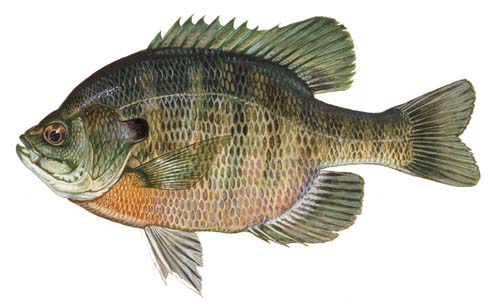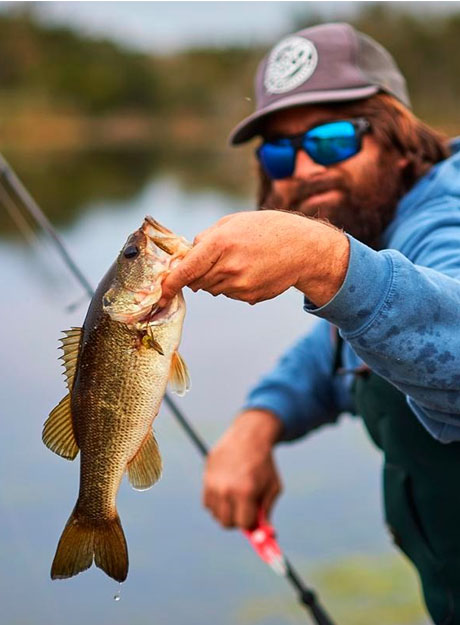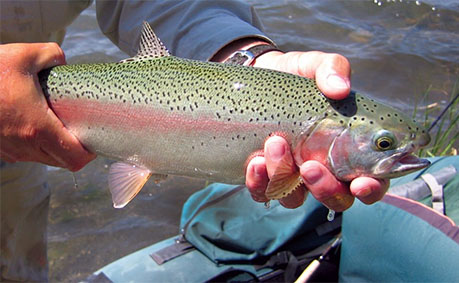Bluegill is a small panfish that makes an excellent table fare. They are commonly found in ponds and lakes near vegetation and structure. The best technique for catching Bluegill is spin casting using worms for bait although they will also take jigs and flies.

Habitat: Bays, Lake, Pond
- How to identify a Bluegill
- Where to catch Bluegill
- How to catch Bluegill—Best Techniques
- Ice Fishing for Bluegill
- Best Baits, Lures and Hooks—Keep Them Small
- Recommended Tackle and Setup
How to identify a Bluegill
Like the typical sunfish, the body of the bluegill is flat/round. Its coloration varies from dark hues of olive-green to blue-green. They can also be void of color with a translucent appearance. Each side of the bluegill’s body has 6-8 vertical band markings that vary in boldness. Its broad/round gill cover flap is black and lacks the light trim that’s present in other sunfish. Bluegills have small mouths and heads and pointed pectoral fins.
Bluegill are differentiate from other sunfish by the length of the pectoral fin. If you take the pectoral fin of the bluegill and fold it forward toward its mouth and the fin extends beyong the eye, then the fish is likely a bluegill.
Bluegills have a unique black earflap that covers their gills and an identifiable dark spot on their dorsal fin near the tail. Male bluegills tend be brightly colored with pronounced iridescent blue marketings, even an orange throat. Female bluegills are not as brightly colored as males.
Adult bluegills range between 8 and 15 inches, but most of the bluegills you catch are likely going to be in the 5 inch range and weight less than half a pound. Bluegill catches in the 1 lb range are common, but adult male bluegill can weigh in at over 4 lbs. The largest bluegill on record weighed in at 4 lbs 12 ozand was caught in Alabama in 1950.
Bluegill are schooling fish and are often found in small schools of 10 to 20. Interestingly, bluegills tend congregate with other bluegills that are about their same size.
Where to catch Bluegill
The native range of the bluegills includes the eastern U.S. south of the Great Lakes extending to northeastern Mexico. However, as a result of organized stocking programs, bluegills are now common in lakes, ponds and slow moving rivers throughout the United States, including Hawaii. One of the highest concentrations of bluegills is found in the Chesapeake Bay watershed area and it’s tributaries. Bluegills have also been introduced in Canada, Europe, and South Africa.

Bluegills are primarily found in warm, calm waters including lakes, ponds and slow moving creeks and rivers. They prefer habitat with sand, mud or gravel bottoms that provides ample vegetation and underwater structure where they can hide. Bluegills are freshwater fish but can tolerate brackish water environments with salinity levels up to 18 ppt.
The ideal water temperature for bluegills is between 65°F and 80°F, but they can survive in warmer and colder water. Bluegills have been found in water as warm as 90°F and popular target of ice fisherman in the frigid waters of the Dakotas, Minnesota and Wisconsin.
Bluegill move around a lot and are found in different habitats at different times of the year. The following chart shows likely bluegill habitats during spring, summer, fall and winter.
| Season | Habitat |
|---|---|
| Spring and Early Summer | Bluegill spawn in spring and early summer. During spawn they are typically found in the shallows guarding their nests—which are marked by groups of round craters along the bottom. Cast your line beyond the nest groups and retreive your bait through the nesting colony. Bluegills will guard their nests aggressively and take any small lure or baited hook. |
| Late Summer | During later summer bluegill move to deeper waters (10+ feet). Fish along the outside edge of weed beds, flooded timber, brush piles and other cover. During mid to late summer, the best fishing is typically in the morning and evening when bluegill are most active. |
| Fall | During early to late fall bluegill can also be found in shallower water near weed beds, brush piles, and other cover. As water temperatures cool anglers can fish in the morning, evening, and during midday. |
| Winter | As water temperatures drop during winter bluegill move to deeper water. They'll be found in schools congregating near underwater structure near the bottom at depths of 10 to 20 feet. Bluegill feed all winter but are less active. Use small baits and slow presentations to get a bite. Use very light tackle so you can detect when you have a bluegill on the line. |
The following are habitats where you can catch Bluegill:
- Freshwater Weed Beds
- Gradual Shores
- Lake and Pond Fishing Holes
- Inlets and Outlets
- Open Water
- Piers, Docks and Pilings
- Shoreline Shallows
- Springs Holes
- Sunken Objects
- Walkways and Bridges
How to catch Bluegill—The Best Techniques
Bluegill have excellent sight with eyes that can easily sense any small moving object within their vecinity as long as their is light. Consequently, bluegill tend to feed during daylight hours from dawn until dusk. They often feed in open water during the day and move inshore to feed at night.
Anglers who use light tackle find the bluegill an exciting and challenging fish. The best time of year to catch them is in spring and summer. These fish are easy to catch and are a great option when fishing with kids. Most people fishing for bluegill will spin cast with a hook and worm. When fishing with worms, it’s important to use small worms, or pieces of worms, just large enough to cover the hook. Remember, even adult bluegills have small mouths.
Adding a bobber to the line will help you detect when a bluegill has taken the bait. Since their mouths are small, jigging with small hooks can also prove successful.
The following are effective fishing methods and techniques for catching Bluegill:
| Fishing Technique | Description |
|---|---|
| Bobber Fishing | Most popular and effective technique for catching bluegill during the summer months. Provides a motionless presentation that is ideal for attracting bluegill. Place your baited hook on your line 1-3 feet below a bobber that is just big enough to float your bait. If bluegill are deeper, you'll need to increase the distance between the bobber and baited hook. Using a slip bobber rig will allow you to easy adjust the depth of your bait. |
| Bottom Fishing | Cast your bluegill rig with a light weight and allow it to sink slowly to the bottom. You want to use as light a weight as possible so bluegill don't feel resistance when they take the bait. Sometimes bluegill will actually take the bait as it sinks to the bottom. Once your rig is on the bottom, wait a few minutes, reel in and cast again. Bottom fishing works well during early spring and cooler months when bluegill are in deeper water. |
| Drift Fishing | Effective technique for catching bluegill in lakes, especially toward late summer when they can be found in open water. Drop your bait down about 10-12 feet and drift across the lake until you get a bite. Repeatedly drift the areas where you've gotten bites and you'll likely get more since bluegill travel in schools. |
| Fly Fishing | Fly fishing is a fun and exciting method to fish for bluegill. It's also more effective than most anglers realize. An artificial fly looks a lot like the small insects bluegill feed on and they'll readily take a fly. Bluegill are not picky and will take just about any fly pattern. Small black flies work the best. |
| Trolling | Trolling is not the most common approach to fishing bluegill but it can be effective for targeting larger bluegills that move away from weedbeds in open water during the warm summer months. Troll slow around 1 mph using jigs (1/64 oz. to 1/16 oz.) tipped with tube plastics or curly tail. Small butterfly or smile blade style spinners will also work. |
Ice Fishing for Bluegill
Ice fishing for bluegill is a fun pastime during winter months when many gamefish become sluggish and stop feeding. Bluegill continue to feed heavily throughout the winter and will readily take your bait or lure. The key is finding where they’re at under the ice.
I highly recommend scouting the area you’re going to fish before freeze up to get any idea of where you’re likely to find bluegill once the lake is frozen over. If you can’t prescout, use a bathymetric map or fish finder to find bluegill. During early winter and spring, bluegill are going to hold up near the inside edges of weed beds in about 5-10 feet of water. As water gets colder and vegetation dies off, bluegill will push into deeper water (15-20 feet) to areas with flat, soft bottoms where they feed on insect larvae. If all else fails, just drill holes in likely areas until you strike paydirt.
The most effective lures and baits for ice fishing bluegill are brightly colored tear drop jigs, live wax worms, meal worms, mousies (aka “rat-tailed maggots”) and small grubs. Remember, when it comes to bluegill fishing think “small.” You want to keep your bait and presentation small. This is especially true during the winter when these fish are not quite as aggressive. I recommend using a No.8-No.10 size jig or hook—and bait to match.
The ideal setup for ice fishing bluegill is a simple bobber rig. Just set your bobber on your line so that your bait is suspended about 1 foot off the bottom. Using slip bobber rig of some fashion that allows you to easily adjust the position of your bobber and depth of your bait will save a lot of time and hassle.
Once you’re bait is in place, give your line a twitch ever 30 seconds or so to get noticed, and hopefully induce a bite. If you’re not having any success after about 10 minutes move to a new location.
Best Baits, Lures and Hooks—Keep Them Small
The general setup to catch a bluegill is a simple line and hook baited with a live worm. Bobbers can added to indicate when one a bluegill is biting your line. Using a bluegill rig is helpful for present bait in a way to attract a bite.
Bluegills are not picky feeders. They will take a variety of baits and lures. Their natural diet includes vegetation, zooplankton, insects, larvae, small crustaceans, smaller fish and fish eggs. The most effective baits for catching bluegills are worms and nightcrawlers. Other effective baits include grasshoppers, crickets and meal worms.
Artificial lures, flies and hooks should be small. Optimal hook size for catching bluegill is between No. 6 and No. 10. Using a long shank hook will allow you to easily remove the hook from the mouth of the bluegill.
While bluegills prefer bait, they’ll readily take an artificial lure if it fits in their mouth. Some of the most effective lures for fishing bluegills are black jigs (in the 1/32 ounce range), small spinners, poppers and flies.
When micro-jigging for bluegill in dirty or brackish water try a slightly larger 3/32 oz. jig in bright fluorescent colors that bluegill will see. When water clarity is high, try a smaller 1/64 oz jig in white, silver or gold.
The following are fishing lures, bait and tackle that can be used to catch Bluegill:
Tackle and Setup for Bluegill Fishing
The general setup to catch a bluegill is a simple line and hook baited with a live worm. Bobbers can be added to detect when one a bluegill is biting your line. Using a bluegill rig is helpful for presenting bait in a way to attract a bite.
As adult bluegills rarely reach above 2 pounds, an ultra-light rod and reel combo with a light line is the ideal setup. You also want to make sure you use light weight tackle and line that will allow you to feel when you’re getting a bite. Fishing line in the 2-6 lb test range is ideal. You’ll be able to detect when the fish is biting and this light line is less likely to been seen by a bluegill’s sensitive eyes.



